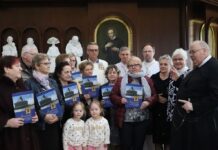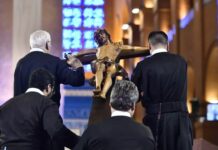We cannot speak of “restructuring for mission” without making a direct connection with those who have already lived and been involved in the mission. In this glimpse at the past, one of the reference points will always be our predecessors’ missionary life and how much they have done to carry out their Redemptorist vocation and mission. And one of these points of reference is St. Clement M. Hofbauer.
In fact, Clement’s entire earthly life was a constant effort to carry out the mission he received. We cannot list, in this brief reflection, all the events – some joyful and others painful – lived in the fulfillment of his mission; for this reason, we will limit ourselves to considering only the “journey to the north” that St. Clement made, in his effort to take the Congregation beyond the Alps, and which can be defined as the “anguishing journey of a courageous and optimistic missionary”. Some events on the road from Rome to Warsaw and during Clement’s stay in Warsaw have drawn our attention (Cf. Chapters VIII-X and XIV in J. Heinzmann, S. Clement Maria Hofbauer. Una Evangelizzazione Nuova, Verona 2009, pp. 51-63.78-80). From this perspective, at the end of this article, we will suggest some questions that can help us reflect on our mission today.
The agonizing journey
- Heinzmann offers us a brief but profound description of the concrete situation of the journey of our Saint towards the North: “Hofbauer and Hübl, in October 1785, left for the North, without money or precise destination, with an uncertain purpose”. How to initiate a mission (for Hofbauer and Hübl the mission was the expansion of the Congregation) with such uncertain possibilities, imprecise destination and with so little money on which to live? This mission was indeed a task filled with challenges and uncertainties. One concrete example: in Vienna – which was the first stop on his journey – during the reign of Emperor Joseph II, at least 800 religious houses had been suppressed. Therefore, these two Redemptorists immediately realized that “it was unthinkable to found a new community, either in Vienna or in Austria” (p. 51).
However, they did not give up so easily in the face of difficulties, and Clement and his companions would continue the journey to Warsaw. For them, that journey was terrible because, as Heinzmann writes, “they advanced along tortuous roads,” and generally remained “soaked” during that harsh winter (p. 53-54). After a long journey, they arrived in Warsaw, but the difficulties were not yet over. During those first days, in the house in Warsaw where they managed to get settled, Clement and his companions, says Heinzmann, “had nowhere to sleep because there was a lack of beds, and there were ‘leaks everywhere’” (p. 56). They dreadfully lacked the necessary elements and essential means to live a normal life. The missionary life of this Saint and his companions, who lived in such poverty, can help us reflect on our own lives today.
Besides the daily and material difficulties, Clement and his companions were immersed in a bleak historical context flooded with animosity. Heinzmann tells us: “more than the terrible economic situation of these early years, the cause of their suffering was the hostile attitudes toward them” (p. 56). They were hated even though they did nothing wrong, as Hofbauer wrote in Vienna in January 1788: “Here they hate us because we are Germans” (p. 56). We know well that at that time, there was a terrible war involving many countries (Russia, Prussia, Austria, Germany, and France). In Warsaw, for example, in 1793, there was a real bloodbath: “much blood runs in the streets […]. The squares and alleys are covered with corpses” (p. 57).
Having said this, we do not intend to make a simple comparison between Clement’s mission and ours today: each historical context has its difficulties and challenges; but it is important to recognize that the genuine life of every missionary involves an arduous and difficult journey, not only toward redemption for oneself and others but also because of the economic and social events of daily life. While it is undeniable that missionary life is not easy, it is also true that it is possible to choose to live this life in an audacious way. The way that Clement lived his life and everything he did gives testimony to this.
Bold and confident missionary
We know that it was by chance that the Redemptorists stopped in Warsaw. But, beyond a chance event, we also discover God’s way of intervening in lives: out of man’s fragility, God can carry out his plan and give man his victory.
When they agreed to work in Warsaw, the Redemptorists were asked to rebuild a church, including the adjoining buildings, which “were abandoned and in disrepair,” (p. 55). Our missionaries had to face many difficulties: small and cramped quarters, economic limitations, and as part of their pastoral work, they were also charged with reviving an abandoned church and bring to life a school for poor German children. But how was it possible to work under such conditions? It was barely possible to survive and accomplish this mission. Nevertheless, with faith, apostolic zeal, and pastoral dynamics, St. Clement and his confreres, from that which was at the point of collapsing, built the great St. Benno’s – “a church in which one had the impression of being in a continuous feast” (p. 66).
Although this was a “difficult period,” the missionaries had to discover a way out. In this sense, St. Clement is a valid model for us, especially in pastoral ministry. According to Heinzmann, Clement was able to “discern the pastoral needs of the time and the concrete situations of the place. The guiding principle of his initiatives was not found in the articles of law of the government or the Rule of the community. This authentic missionary received much more from concrete life. In the difficult situations of the time, he knew how to read a call from God. Facts and reality were for him an expression of God’s will” (p. 79). What counted for our Saint was not so much a particular way of acting, but the fact that the divine will be found in the difficult situations of the moment and everyday events. With this principle and with love for God and the abandoned, St. Clement “found new ways to realize the ideal of the Redemptorist” (p. 79), which is “Plentiful Redemption” that “affects the entire person” and “brings to perfection and transforms all human values” (Const. 6). It is in the dynamic and fervent manner of St. Clement’s pastoral practice that we can indeed find one of the crucial points in the apostolic life of Redemptorist missionaries: “According to the situations in which they find themselves, they will eagerly try to discover what they should do or say” (Const. 8). Despite all the economic and social difficulties they faced for nearly twenty years at St. Benno’s, St. Clement was fully convinced that “the sustenance of St. Benno’s was the continual miracle granted by Divine Providence”. (p.63).
Speaking of St. Clement in the period of 1787-1808, Heinzmann briefly concludes with these words: “Despite his limitations, this man carried within him a heart that knew no bounds” (p.80). The expression “a heart that knew no bounds” can also inspire our consecrated life, our pastoral ministry, and our relationships. In St. Clement, we truly see a heart without limits that tends towards God, towards the confreres and people. Such a “heart without borders” certainly requires of us an immense openness to others, an acceptance of the adversities of life and work, a fraternal availability to the needs of the poor, and an ardent commitment to all that God offers us in the events of daily life.
Questions for Reflection
- Do we have the audacity to undertake the Redemptorist mission in a new place, without assurances or guarantees, as our predecessors did?
- If, as St. Clement saw it, God were to put us in an adverse situation (economic, social, or historical), what would be our reaction?
- In today’s complex and contradictory world, what would be our consecrated and missionary life initiatives as Redemptorists?
- As Redemptorists in our wounded world (manipulated by the media and influenced by consumerism, etc.), what can we do concretely (hic et nunc) to truly live our vocation?
Prayer
O God, your Providence allows
that the kingdom of Christ be extended to the ends of the earth
and allows all men to share in the benefits of Redemption.
Ignite with your fire the heart of every Redemptorist
so that, aware of the call we have received,
we can work for the salvation of all persons,
until all Societies grow as one family
and recognize themselves as your people.
We ask this through Jesus Christ, our Redeemer.
—————————————————————————————————–
 ONE BODY is a monthly prayer text proposed by the Center for Redemptorist Spirituality.
ONE BODY is a monthly prayer text proposed by the Center for Redemptorist Spirituality.
This text was written by John NGUYỄN NGỌC HẢI, CSsR.
Translation: Cristian Bueno, C.Ss.R.
For more information: Piotr Chyla CSsR (Director of the Center for Spirituality – fr.chyla@gmail.com).







